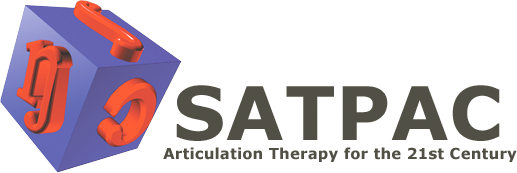For Successful Articulation/Phonology
December 8, 2011 6:09 pm
![]() for Speech-Language Pathologists & Audiologists
for Speech-Language Pathologists & Audiologists
August 15, 2005 – Vol. 15 – Issue 33 – Page 14
By Stephen Sacks, MA, CCC-SLP
With a nod to Ron Clark, Disney’s American Teacher of the Year in 2001 who wrote The Essential 55, about discovering the successful student in each child,1 I have developed “The Essential 10 for Successful Articulation/Phonology Therapy.”
Based on my 25 years as a school speech-language pathologist, I have found the following to be essential:
- a solid foundation,
- perfect practice,
- mandatory homework,
- repetitions per session,
- systematic therapy,
- hierarchy,
- natural prosody,
- coarticulation,
- conversational rate and
- change occurs over time.
A solid foundation is essential. In order to successfully remediate articulation/phonology disorders, oral-motor issues often have to be addressed before working directly on the sound. For example, if students cannot make the /r/ sound, can they retract the tongue appropriately and grade the jaw to be able to consistently retain the proper position? Can they differentiate the tongue movement from the lips and the jaw when attempting to say the sound?
For the /s/ sound, can students differentiate the front from the back of the tongue so they can stabilize the back part of the tongue and use the tongue tip independently? For the /k/ sound, can they differentiate the tongue movement from the jaw, keeping the mouth open and still while retracting and elevating the back of the tongue? If the answer is no to these questions, direct speech therapy to remediate these sounds will be difficult, if not impossible.
Another essential is perfect practice. As therapists, we need to provide accurate and timely feedback to our students while they are learning to correct their deficits. We need to reinforce correct products and discourage the incorrect ones. Like with a golf swing, we are dealing with motor memory. If a student with an /r/ problem puts his tongue in the incorrect position and makes an incorrect /r/ and does not know the production was incorrect, it becomes more difficult to establish the correct /r/ sound in the future.
If students have group therapy for articulation once a week, they may make 50 to 100 correct productions during a half-hour session, while making hundreds of incorrect productions the rest of the day. Just five to 10 minutes of practice five days a week reinforces the correct productions and leads to eventual success by moving students more quickly into transfer so they are making some correct productions during the part of the day they are not in therapy.
Because students typically make hundreds of incorrect productions outside of therapy in a typical day, there needs to be many correct productions to change that behavior. The number of repetitions per therapy session is another essential element of successful articulation/phonology therapy. One of my professors in college had said there should be 500 correct productions in a therapy session. While that seemed unreasonable at the time, over the years I have worked up to close to that number in a focused 25-minute session.
Systematic therapy also is important. Many times I have seen therapists asking students to make sentences with their target sound when they don’t have the sound clearly established yet. Sounds need to be established in a single context, generalized into every phonetic context, and finally transferred into phrases, sentences and conversation.
Along the same line, there should be a hierarchy in therapy. I recommend bisyllable words followed by phrases. Structured sentences should follow.
For example, if /s/ is the target, structured sentences might be “I want a sock” or “I want a seat.” Follow with varied sentences like “I bought a new sock” or “Can I have your seat?”
To increase the number of correct productions, a contrastive stress strategy works well. Continue with questions that require the student to generate the word for the first time:
Therapist: “Is that a shoe?”
Student: “No, a sock.”
When the student can generate successful target sounds, I recommend conversation and/or reading with discussion as the terminal step in structured therapy.
In conversation we use natural prosody and do not focus on any particular sound. In therapy there is often an unnatural emphasis on the target sound. For quicker transfer to conversation, practice should emulate natural conversation as much as possible. At the bisyllable level and phrase level, stress should vary. A contrastive stress model is suggested at the sentence level to take emphasis away from the target sound.
For example, if the target is /s/ and the sentence is “A boy bought a big sandwich,” ask questions after the student says the sentence. A sample question is “A girl bought a big sandwich?” The student would reply, “No, a boy bought a big sandwich.” The student is then asked, “A boy stole a big sandwich?” The student replies, “No, a boy bought a big sandwich.”
Because we speak in phrases and sentences and not in isolated words, practice is most efficient in the same manner. Target sounds should not be the initial or final sound of the practice word. To effectively target a sound, it should be in a coarticulatory context. A CVCCVC bisyllable with the target in either the third or fourth position is the most efficient.
For instance, if the target sound for a student with a frontal lisp is /s/, a nonsense bisyllable like “beetseek” is recommended. There is an added advantage of using a facilitating context. The /b/ requires no tongue positioning, and the /ee/ moves the tongue back into the lingua-alveolar position, followed by the /t/ also in the lingua-alveolar position. When the duration of /eet/ is lengthened, it turns into the correct /s/ sound, as in /eets/. This is again followed by /ee/, keeping the tongue in the lingua-alveolar position. Finally, the /k/ will have the tongue moving back, making it less likely to protrude into the lingua-dental position.
Practice should simulate real conversation as much as possible. To transfer practice into conversation, the practice has to be at a rate that is comparable to conversation. If practice occurs at the rate of 100 beats per minute (BPM) per syllable using a metronome and slow conversational speech is 140 BPM, transfer will not occur. Practice must be at least at a slow conversational rate.
The final essential element of articulation/phonology therapy is that change occur over time. Keeping this principle in mind means that therapy needs to provide time for growth. Given an option of five therapy sessions in a week vs. five therapy sessions weekly, the latter is preferable.
I have had several successes with a student who had a chronic /r/ or /s/ deficit remediate in six sessions or less. This has happened due to significant changes occurring from one weekly session to the next. The student performs homework diligently and returns the following week looking nothing like the student of the previous week due to significant growth.
References
1. Clark, R. (2003). The Essential 55: An Award-Winning Educator’s Rules for Discovering the Successful Student in Every Child. New York: Hyperion.
Stephen Sacks has been a speech-language pathologist in the schools for 25 years. He can be contacted at steve@satpac.com.
Copyright å©2005 Merion Publications 2900 Horizon Drive, King of Prussia, PA 19406 – 800-355-5627 Publishers of ADVANCE Newsmagazines www.advanceweb.com
This article was published by ![]() for Speech-Language Pathologists & Audiologists
for Speech-Language Pathologists & Audiologists
August 15, 2005 – Page 14



